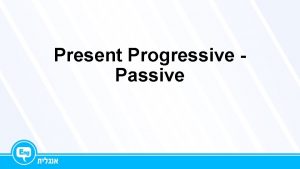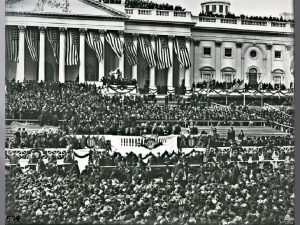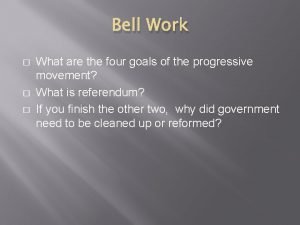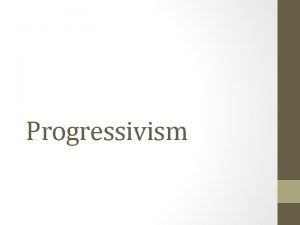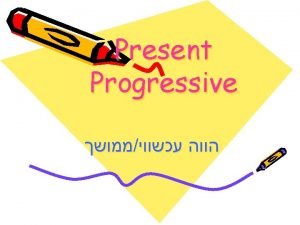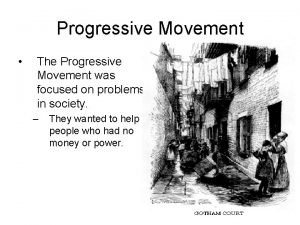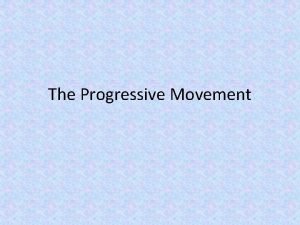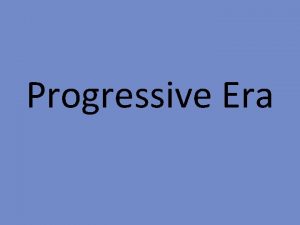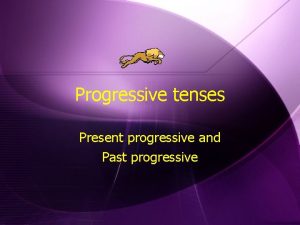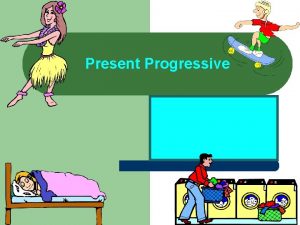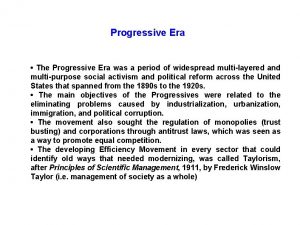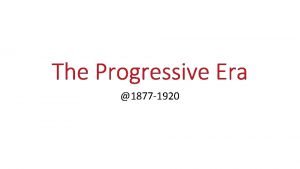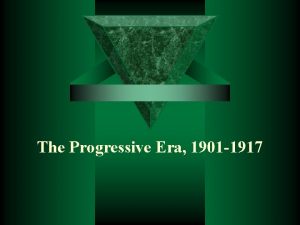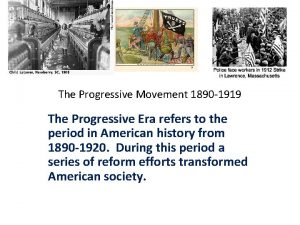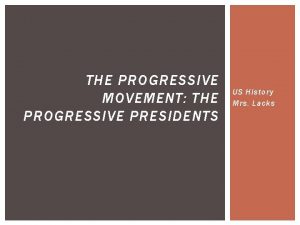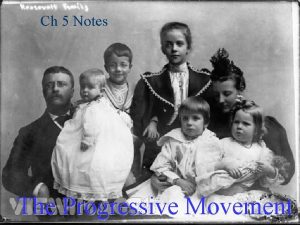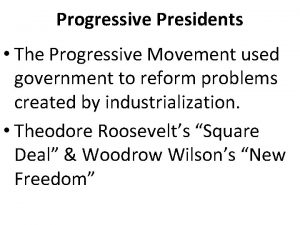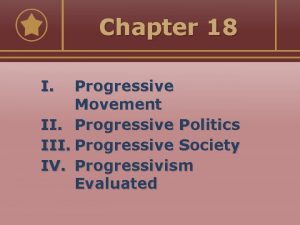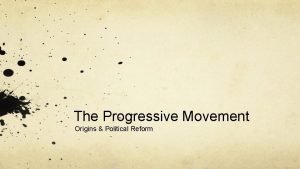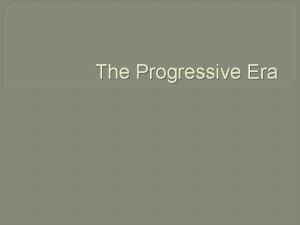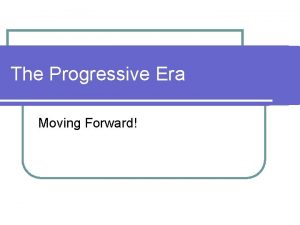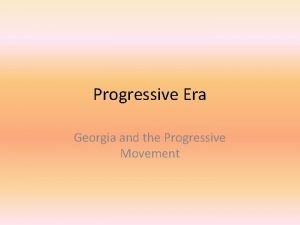Progressive Movement The Progressive movement was a period













































- Slides: 45

Progressive Movement The Progressive movement was a period in our history around the turn of the century in which many individuals worked to improve or reform society to improve life.

Negative Effects of Industrialization By the mid-1800 s half the people working in the textile mills of the Northeast were kids your age.

Little Laborers They were young boys and girls, some as young as first-graders, working 12 hours a day, and often late into the night. They worked in dangerous textile mills, where clanging machines caused many of them to lose their hearing or their fingers. They worked in mine shafts that were pitch black except for the flicker of tiny gas lanterns atop their hats. They worked in cotton fields and cranberry bogs, backs bent and fingers raw. They stood on street corners selling newspapers in the freezing cold and pouring rain. They wielded sharp knives, prying shellfish apart. Child labor was America’s sad secret in the years between 1865 and the 1930 s. Manuel, the five-year-old shrimppicker shown here, spoke no English. At the time this photograph was taken, he had already worked for a year in this hazardous occupation.

When I grow up I want to be. . . … Eight-year-old, Jennie Camillo wades through a mushy cranberry bog. Injuries were an everyday occurrence in the dangerous mills and factories.

Child’s Play (here are some other jobs kids had) PIECE WORK Newsies In the days before TV and the Internet, people got the latest news from newspapers sold by small children on street corners. MESSEGNARS These children worked well into the night, earning 35¢ for every Urgent messages sent 1500 artificial flowers they made. by telegraph were The flowers were used to adorn delivered by youngsters clothing and women’s hats. who were “on call” day and night.

This bobbin girl at a textile mill in Boston had to make sure all the spools were properly threaded at all times A Nine-year old oyster worker pries a shell apart with a sharp knife

What negative consequences existed for children who worked through their childhood? Children who worked through their childhood did not have the opportunity play with their friends, get an education, and were often injured because of the dangerous jobs they performed.

Hope for the Future How could America prosper with a generation of children who worked all day and barely went to school? Something had to be done. Several organizations were started to protect factory workers from bosses who exploited them. These new groups, called trade unions, were formed, and by the late 1800 s the first proposals to reform child labor laws began to be discussed.


How did children begin to be protected from this type of abuse? In 1904 the National Child Labor Committee (NCLC) was founded to end the tragedy of small children who had been deprived of their childhoods.

We Will Not Work As America’s businesses grew, people were being forced to work longer hours, in ever-worsening conditions, for low pay. The fight to change things led to great struggles and sometimes violence.

Words to Know Labor Union: A group of workers who have banded together to improve working conditions or get higher pay.

Words to Know Sweatshop: A workplace that pays low wages, has unsafe conditions, and demands work quotas that are almost impossible to achieve.

Sweatshop Life By Sadie Frowne who came to America from Poland “At seven o’clock we all sit down to our machines and the boss brings to each one the pile of work that he or she is to finish during the day…The pile is put down beside the machine, and as soon as a skirt is done it is laid on the other side of the machine. Sometimes the work is not all finished by 6 o’clock, and then the one who is behind must work overtime…The machines go like mad all day, because the faster you work the more money you get. Sometimes in my haste I get my fingers caught and the needle goes right through it. It goes so quick, though, that it does not hurt much. I bind the finger up with a piece of cotton and go on working. We all have accidents like that. Where the needle goes through the nail it makes a sore finger, or where it splinters a bone it does much harm. Sometimes a finger must come off…”

The Rise of the Labor Union Many industries, from steel to textile workers began forming labor unions. The idea was that if all the worker’s unions gathered together into one huge organization they would be able to improve their workplace faster. Samuel Gompers, who had arrived in America as a 13 -year old immigrant, helped build such an organization. Young Gompers worked long hours in a sweatshop, making cigars. In time, he joined a union of cigar makers and rose to become its president. In 1886 Gompers became president of the American Federation of Labor (AFL) which organized all the labor unions in the United States into one powerful group. The AFL’s first act was a national strike to call for an eight-hour workday for union workers. In the years to come, using strikes, boycotts, and negotiations, the AFL became a powerful voice for many of America’s workers.

What advantage does a worker have when he or she is part of a labor union? A worker has a better chance of getting fair pay and safe working conditions.

How was the American Federation of Labor organized? In 1886 Gompers became president of the American Federation of Labor (AFL), which organized all the labor unions in the United States into one powerful group.


Look closely at the AFL seal. How does it reflect what AFL was trying to accomplish? The AFL’s first undertaking was to call for an eight-hour workday for union members.

The Homestead Strike of 1892 Some unions did not join the AFL. One such union worked at a steel plant in Homestead, Pennsylvania, owned by Andrew Carnegie. After several years of union activities, Carnegie felt the steel mill was losing money. In June of 1892, workers were told their pay would be cut and the union would be broken up. If they did not agree, they would be fired. Naturally the union refused, so Henry Frick, the man running the mill, ordered the workers locked out of the steel mill. A barbed wire fence was built, and water cannons (a hose that fires water under high pressure to break up crowds ) were placed at each entrance. Frick hired replacement workers (scabs) while the union angrily vowed to keep them out. When gun-toting security guards (Pinkerton’s) arrived to protect the new workers, deadly violence followed. Thousands of angry workers gathered and tried to massacre the security guards—even after they tried to surrender. More than 8, 000 federal troops had to be brought in to restore peace. In the end, the brutality of the union steel workers cost them the loss of public support. In mid-November the union was broken up and wages were cut, a 12 -hour workday was ordered, and more than 500 jobs were eliminated.

As security guards tried to protect the “scabs”—the men taking the Striking Homestead workers’ jobs—there were terrible acts of mob violence.

The Battle At Fort Frick The Homestead Strike was one of the most violent in U. S. history. What was at stake? Cast Narrator William Roberts John Mc. Luckie Hugh O’Donnell Jim Klein Scout Frederick Heinde Henry C. Frick Martin Murray Joe Sotak A. L. Wells Charles Nordrum Sally Murray Paul Murray 1 st Woman 2 nd. Woman Sam Cluley 1 st Striker John Potter Rider 2 nd Striker

10 Days That Unexpectedly Changed America: The Homestead Strike Disc 2 4: 27 – 9: 38 (5 min 11 sec)

What occurred at Andrew Carnegie’s steel plant in Homestead, Pennsylvania in 1892? A strike broke out when workers were told they must break up their union and accept a pay cut or they would be fired.

How did the federal government become involved in the Homestead strike? More than 8, 000 federal troops had to be brought in to restore the peace at Homestead after a violent fight broke out between union members and the security guards Henry Frick hired to protect the replacement workers.

How did the Homestead Strike End? The Homestead steel workers union was broken up and wages were cut. A 12 -hour workday was put in effect and more than 500 jobs were eliminated.

Hope in the Workplace In spite of many violent clashes, the union movement was here to stay. In the coming years, union actions would result in safer jobs, decent wages, and reduced work hours for thousands of Americans.

The Triangle Fire The sweatshops of New York City’s textile industry were terrible places to work, but on the evening of March 25 th, 1911 they became deadly as a fire broke out on the eighth floor of the Triangle Shirtwaist Factory. The blaze ripped through the Triangle Building while young immigrant women desperately tried to make their way downstairs. The Triangle Shirtwaist Company always kept its doors locked to ensure that the young immigrant women stayed stooped over their machines and didn’t steal anything. The locks sealed the workers’ fate. Witnesses thought the owners were tossing their best fabric out the windows to save it, then realized workers were jumping, an eerie precursor to the World Trade Center. By the time the fire burned itself out, 146 people were dead, and nearly half of them were teenage girls. The company’s owners, Max Blanck and Isaac Harris, had fled to the building’s roof when the fire began and survived.

The public outcry at the news of the mass deaths at the Triangle Factory was swift and loud. People demanded changes that would safeguard workers.

Newspapers and labor unions led the charge for government action.

The government was partially to blame for the fire. Not only were the laws inadequate, but enforcement of them was poor. Four investigations were launched to see who was at fault.

In October 1911 a law was passed that established the Bureau of Fire Prevention so that disasters like the Triangle Shirtwaist Factory Fire could be prevented.

America the Story of Us Disc 2: Cities Triangle Shirtwaist Factory Fire 38: 50 -45: 45 (6 min 55 sec)

Triangle Fire http: //www. youtube. com/watch? v=87 SCTEs. Iuf. Y&list=PLyopg. BQYEqtjzb 6 cgco. U 1 f. Ze. F 19 IKOYUK

Working Conditions 0: 00 – 5: 00 Start of fire 8: 00 – 11: 00 Tight space 14: 00 – 18: 00

Why did so many women die in the Triangle Shirtwaist Factory Fire? The Triangle Shirtwaist Company bosses locked the fire doors to keep their workers from stealing, so when the fire broke out they could not escape.

What do you practice in school to help protect you from injury that was a direct result of the Triangle Shirtwaist Factory Fire? fire drills

Words to Know Progressive (pruh-gress-iv): Pushing for change in the hope it will improve life.

The Progressive Movement America’s workplaces were dangerous and unsafe, and many big companies were working their employees to death. How many would have to die before something was done? The Progressive Movement set out to change all that. Pictured above are three of the forty bodies from the Triangle Shirtwaist Factory Fire that jumped from the building’s east side.

Fixing What Was Broken The Progressive Movement was started to help fix all that was broken in American society, from abuses in the workplace to “political machines” that cheated to win elections. There was so much to fix: terrible poverty among new immigrants, unsafe factories, and children laboring in sweatshops instead of getting educations that might lift them out of poverty.

Meet the Muckrakers In a popular book of the times, one of the characters was forced to rake filthy mud endlessly, never looking up from his awful labors. Stuck in the muck forever, his life seemed hopeless. The Muckrakers, a group of photographers and writers, took their name from this character. The Muckrakers vowed to make Americans aware of all the injustice in the nation, and America’s newspapers and magazines were soon full of stories of sadness and scandal. Readers were heart-sick by what they read and saw and cried out for change. Pictured from top to bottom, left to right: photographer Lewis Hine, writer Upton Sinclair, and reporter Jacob Riis.

A Change For the Better Through words and photos, in books and magazine articles, talented men and women began to expose all the ugliness of American life. The Progressive Movement began to bring about great change in the nation, especially in the workplace. Safety conditions were improved, work hours reduced, and the first child labor laws were proposed. New constitutional amendments changed the way we held elections. Women, who had long been activists in the cause of humanity, began to demand the right to vote. Those women, aware that alcohol abuse was a terrible problem, also began working to ban the sale of liquor.

What issues did the Progressive Movement attempt to tackle? The Progressive Movement focused on political corruption, poverty among immigrants, unsafe factories, child labor, powerful monopolies, and improving our food and drug quality among other things.

Words to Know Reform: To make better or improve.

Name three changes in our workplaces brought about by the Progressive Movement reforms? During the Progressive Movement safety conditions in the workplace improved, work hours were reduced, and the first child labor laws were proposed.
 Stability period vs measurement period
Stability period vs measurement period Absolute refractory period and relative refractory period
Absolute refractory period and relative refractory period Less complicated texture than baroque (more homophonic)
Less complicated texture than baroque (more homophonic) Trustee period and royal period
Trustee period and royal period Critical period vs sensitive period
Critical period vs sensitive period Non metal halogen family 35 amu
Non metal halogen family 35 amu Cynthia lightfoot
Cynthia lightfoot Bc va ad
Bc va ad Critical vs sensitive period examples
Critical vs sensitive period examples Important key points of period of activism
Important key points of period of activism A&p flix activity: resting membrane potential
A&p flix activity: resting membrane potential Approaches to child development
Approaches to child development Past simple and past progressive
Past simple and past progressive Function past perfect
Function past perfect Present progressive passive
Present progressive passive Progressive reformers attacked political machines because
Progressive reformers attacked political machines because Chapter 6 lesson 3 the wilson years
Chapter 6 lesson 3 the wilson years What were the four goals of the progressive movement?
What were the four goals of the progressive movement? Hổ sinh sản vào mùa nào
Hổ sinh sản vào mùa nào Diễn thế sinh thái là
Diễn thế sinh thái là Vẽ hình chiếu vuông góc của vật thể sau
Vẽ hình chiếu vuông góc của vật thể sau Công thức tính độ biến thiên đông lượng
Công thức tính độ biến thiên đông lượng Phép trừ bù
Phép trừ bù Tỉ lệ cơ thể trẻ em
Tỉ lệ cơ thể trẻ em Thế nào là mạng điện lắp đặt kiểu nổi
Thế nào là mạng điện lắp đặt kiểu nổi Lời thề hippocrates
Lời thề hippocrates Vẽ hình chiếu đứng bằng cạnh của vật thể
Vẽ hình chiếu đứng bằng cạnh của vật thể đại từ thay thế
đại từ thay thế Quá trình desamine hóa có thể tạo ra
Quá trình desamine hóa có thể tạo ra Môn thể thao bắt đầu bằng từ đua
Môn thể thao bắt đầu bằng từ đua Sự nuôi và dạy con của hổ
Sự nuôi và dạy con của hổ Hát kết hợp bộ gõ cơ thể
Hát kết hợp bộ gõ cơ thể Dạng đột biến một nhiễm là
Dạng đột biến một nhiễm là Biện pháp chống mỏi cơ
Biện pháp chống mỏi cơ Trời xanh đây là của chúng ta thể thơ
Trời xanh đây là của chúng ta thể thơ độ dài liên kết
độ dài liên kết Chó sói
Chó sói Thiếu nhi thế giới liên hoan
Thiếu nhi thế giới liên hoan Fecboak
Fecboak điện thế nghỉ
điện thế nghỉ Một số thể thơ truyền thống
Một số thể thơ truyền thống Thế nào là hệ số cao nhất
Thế nào là hệ số cao nhất Hệ hô hấp
Hệ hô hấp Frameset trong html5
Frameset trong html5 Các số nguyên tố là gì
Các số nguyên tố là gì đặc điểm cơ thể của người tối cổ
đặc điểm cơ thể của người tối cổ














